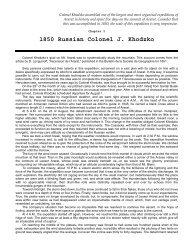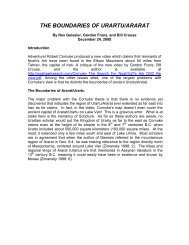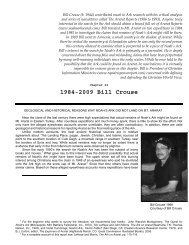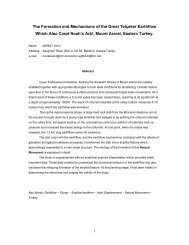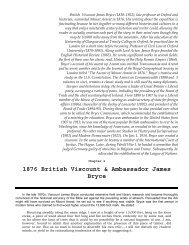2004-2006 Murat Avci
Durupinar's Great Telçeker Earthflow Geologic Formation
Durupinar's Great Telçeker Earthflow Geologic Formation
You also want an ePaper? Increase the reach of your titles
YUMPU automatically turns print PDFs into web optimized ePapers that Google loves.
<strong>Murat</strong> <strong>Avci</strong> 439<br />
landform detached and crept down until it became part of the colluvial materials which accumulated in the cone shaped<br />
valley. The narrow end of the cone was the only outlet to drain water from this small basin. As materials piled up in the<br />
upper sections of the valley, a constant pressure is being supplied on to the colluvial materials which caused the<br />
development of a kinetic energy. While the energy increased in the materials by constant loading, the seeped water<br />
trough the colluvials, on the other hand, held by the ophiolitic bedrock, prepared the needed sliding surface for the<br />
earthflow to happen. Preceding the great slide, the load at the upper mid valley was fed by several small slide tributaries<br />
from above which they later joined at a central area and flowed down as one great slide creating the present Telçeker<br />
earthflow.<br />
The aerial photographs show clearly that the great Telçeker earthflow itself took place in two stages, separated by<br />
minutes or a few hours. The clear boundary line between the two flows is seen in figure 2, at point S. Possibly, tremors<br />
from the first flow triggered the second which followed the same curve, sweeping material from the older slide in front of it,<br />
materials that might have been still well saturated with water. The flow ran 1.2 km past the only outlet of the basin. Two<br />
hundred metres before it stopped, the flow made a turn of almost 90 degrees to the East; exactly at the point where it<br />
crosses the Dogu Beyazit fault line. The fault was there long before the earthflow, which simply adapted itself to the<br />
existing topography. Meanwhile, the shiplike feature was carried and shaped within the older section of the flow. Although<br />
the surface characteristics of the two flow stages are similar, they are<br />
distinguishable by the slight difference in flow direction and the surface texture.<br />
It is interesting to note that all the smaller slide tributaries from different parts of the valley floor moved down at the<br />
same time though they were distant from each other- suggests a regional triggering agent along the following lines: First,<br />
a period of heavy precipitation and/or excessive snow melt followed by an earthquake tremor (quite common in this<br />
region). This combination could have initiated all the initial flows and consequently the main (Telçeker) flow.<br />
Anyhow, the lithology and climate in the area are synchronous to produce varied examples of landslides. For<br />
example, an incomplete slumping can be observed in figure 2 PS, developed before and independent of Telçeker<br />
earthflow. The arrows indicate the circular trace of a slump-type landslide which occurred in the homogeneous part of the<br />
ophiolites. The block in view was rotated at its circular sliding surface for several metres but left no apparent topographic<br />
anomaly. Because, it is clear that the sliding cycle of the slumping process was incomplete, probably because of some<br />
obstruction in the foot area. While it stood at its position as a potential slump, the Telçeker earthflow material moved in<br />
and covered this foot area ( R ), creating a natural retaining wall which prevented further slumping.<br />
IV- How The Shiplike Feature Was Formed<br />
Slumps are landslide types which usually take place along a circular plane; the slid material is not transported far but<br />
is heaped at the root of the scarp. The circular sliding motion is somewhat similar to the motion of a human being trying to<br />
sit down while his back is against a wall. During this motion, the body moves down while the legs are bent like a hinge to<br />
prevent loss of balance. During the sliding process, the underlying soft unit (because of its homogeneity) is isotropically<br />
squeezed down, (representing the legs), it absorbs, and slows down the pressurising energy of the upper consolidated<br />
heavy unit (the body) which consequently prevents its unbalanced collapse and deformation. Similarly in slumps, if the top<br />
layer is a consolidated rock layer, it is usually not deformed after the slide has occurred. This is exactly what happened<br />
when a huge rock layer first detached and slid down from the overlying fossiliferous limestone unit at the top.The shiplike<br />
feature is a piece of undeformed remnant of the hard limestone, brought down by a slump type landslide.



